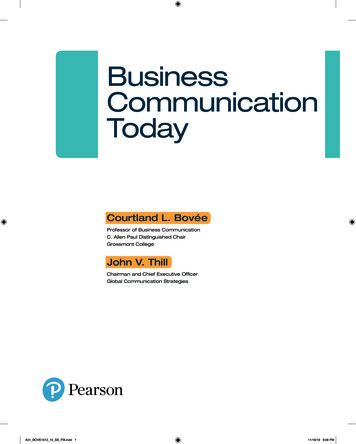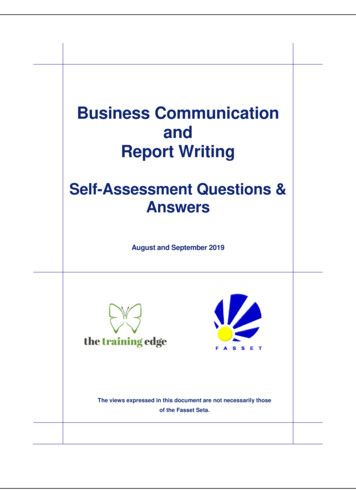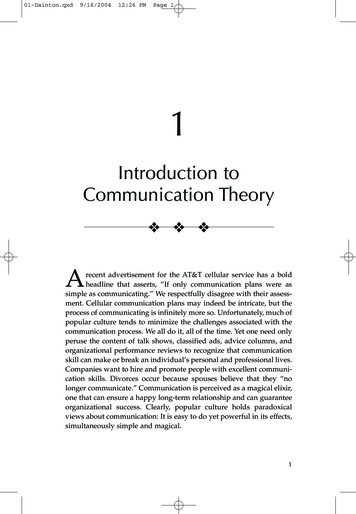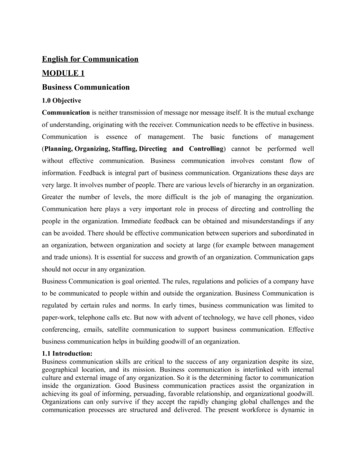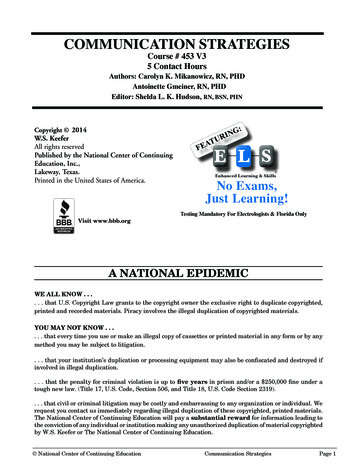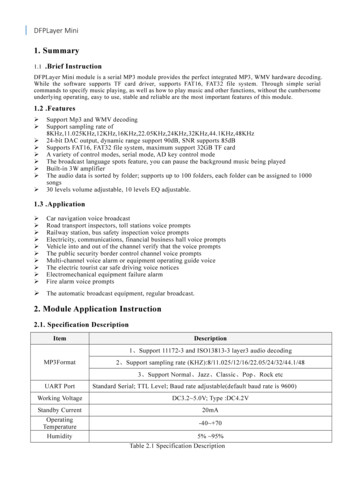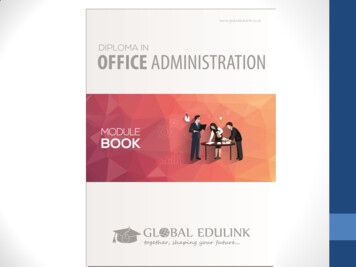
Transcription
Communication Flows in anOrganization DownwardUpwardLateralDiagonalExternal
Downward WorkplaceCommunication: Enabling Downward communication consists of communicationssent from management to workers, like emails andperformance reviews. A manager explains a task to an employee A customer gives an order to a supplier Shareholders instruct management.Continuous .
Enabling These forms have more than direction in common. Each one alsoprovides enabling information in the workplace. When a managerinstructs an employee, she enables the employee to do his job, andmakes it possible for him to earn a living by doing something thathas value for the employer. Another example: senior management finds out from shareholders,or the board of directors, how owners want to apply the moneythey've invested.Continuous
Information moves downwardMake a Budget reportMake a Budget report for the month to include the followingMake sure the report includes the exact amount and the qty.
Purposes Business Goals can be share Providing feedback on employees performance Giving job instructions Providing a complete understanding of theemployees job as well as to communicate them howtheir job is related to other jobs in the organization. Communicating the organizations mission and visionto the employees. Highlighting the areas of attention.
Error-free downwardcommunication Specify communication objective Ensure that the message is accurate, specific andunambiguous. Utilize the best communication technique to convey themessage to the receiver in right form
Upward Communication Information flow from the lower levels of a hierarchy tothe upper levels A second major flow of communication is upward, fromemployee to supervisor, supervisor to department head,department head to vice president, and so on.
Purposes ProductivityFeedbackPromotionConsiderations
Lateral/Horizontal Communication that takes place at same levels of hierarchyin an organization. First, no superior/subordinate relationship exists here; it'sstrictly a case of two people with roughly equal amounts ofpower and prestige. That makes this form of communicationvoluntary and discretionary.
Purposes It is time SavingIt Facilities co-ordination of the task.It Facilities Co-ordination among team membersIt Provides emotional and social assistance to the organizationalmembers. It help in solving Various Organizational problem It can also be used for resolving conflicts of a department with otherdepartment or conflicts within a department.
Diagonal Communication Communication that takes place between a manager andemployees of other workgroups is called diagonalcommunication. It generally does not appear on organizational chart. Forinstance - To design a training module a training managerinteracts with an Operations personnel to enquire about theway they perform their task.
External Communication Communication that takes place between a manager andexternal groups such as - suppliers, vendors, banks, financial institutes etc. Forinstance - To raise capital the Managing director wouldinteract with the Bank Manager.
The Grapevine Grapevine communication is the informalcommunication network within an organization.
Channel Traditionally , the grapevine Mouth to mouthEmail, Fax, ChatCell PhoneFacebook
Example Suppose the profit Amount of a company is known. Rumor isspread that this much profit is there and on that basis bonus isdeclared. CEO may be in relation to the production manager. they mayhave friendly relations with each other
Purposes Grapevine communication creates a social bond. The grapevine fills in a gap The grapevine in many ways helps keep people honest.
Communication Speed Where downward, upward, and lateral communication arestructured and flow formally through specific channels, thegrapevine goes through multiple channels and even multipleversions.
Best PracticesinCommunicationandBusiness Writing
Effective Business Communication Use the most effective communication channel Clear top-down communication Information from the right source/ level Bad news should be shared by leaders Consider recipient of the news
Effective Business Communication Listen closely to understand communicationConciseness is importantSimplicity Large, complicated wordsBe wary of jargon/ abbreviationsLeave communication lines open for feedback
Which Communication Channel Should YouUse?
Ethical BusinessCommunicationDo : Be Honest, Candid,Timely Promptly correct errorsin communication Ensure free Speech,freedom of assembly,access to openmarketplace Respect culturalbeliefs/ values Balancedcommunication fostersmutual understanding Give credit to sourcesDo not: Use confidentialcommunication for personalgain Guarantee results thancannot be obtained Disobey laws/ public policy
Professionalism in the Workplace Live up to commitments Treat employees at all levels with respect Value others’ time Ethical conduct Friendliness/ Positive attitude Admit mistakes
Professionalism in the Workplace Competence Personal issues do not belong in the workplace Dress Professionally and appropriately Etiquette, punctuality, organization, and dedication to your job Silenced mobile devices
Why is ProfessionalismImportant? Ensures good performanceMotivates EmployeesTeam SpiritMaintains CommunicationFosters positive workplace
Intercultural Business Communication Promote an environment where diversity is welcomed andencouraged Keep it slow, but not too slow Active Listening Do not Make cultural assumptions Limit information conveyed at one time Group information into smaller segments Convey an appropriate respect level
Why is intercultural businesscommunication important? Intercultural business is expandingrapidly Avoid misunderstandings Poor intercultural communicationcan low retention of businesspartners/ suppliers/ customers
How Cultures Differ in Communication
Writing Tips for the BusinessProfessionalClarity is important Main Point should appear in first sentence Use headers/ bullet points to make writing‘scannable’ Limit thoughts/ ideas/ suggestions to one perparagraph
Writing Tips for the BusinessProfessionalWriting should be ‘reader- friendly’ Be concise Avoid jargon/ abbreviations Do not use complex phrasing The message should be clear
Writing Tips for the BusinessProfessionalWriting Should be Carefully Constructed Decide what you want to write before you write it Carefully construct writing that best conveysmessage Look over documents multiple times Cut writing that does not serve a purpose
The Use of Electronic Messagesand Digital Media for BusinessDo:Communication Re-read messages before hitting ‘send’Closely monitor and manage electronic messagingUse corporate policies that are detailed and thoroughMonitor and archive Social media contentKnow risks associated with digital media Take steps to prevent risks
The Use of Electronic MessagesDo Not:and Digital Media for Business Send messages you would not be comfortable with everyoneCommunicationseeing Fail to encrypt outgoing communications Fail to archive content that must be retained for your particularorganization
Projected Expansion inBusiness E-Mail Usage
Delivery of Positive Messages Use letters to deliver positive news outside of an organizationBe DirectUse titles and headers: messages are scannedCore of message should appear in first paragraphUse specific formats and templates provided by companyBe timely in delivery of newsConsider communication channels
Delivery of Negative Messages Do not delay delivery of bad news Give concrete justification for bad news Consider communication mediums Bad news should almost always be delivered in person Present solutions if bad news is a problem to be solvedTreat receiver of news with respectFollow throughDisclose all facts
Business Presentations Know your audience Plan your presentation Less is more Define goals at the beginning of the presentation
Business Presentations Involve the audience; keep them interested Establish credibility of presenter and sources Practice Allow time for questions at the close of thepresentation
siness ReportsFormal ReportsInformal Reports Should be thorough and detailed Consider Should address a specificAudienceaudience Plan Carefully Should be structured in appearance Identifiable Must include references Should include recommendations sections Informationorganized inlogical sequence Easy to Scan Be brief and concise Use white space andinformative lists Should address multipleaudiences Should allow forinformation to be quicklyconveyed
Business Plans Clearly Defined Target MarketState why a business does or should existProduct/Service DescriptionPlan should consider and detail all competitionState goals and objectivesComplete marketing planFinancial Plan: Revenue Data & Evidence Financial Feasibility
posals Split into sections Use images/ photos/ graphics Size is important First section should grab attention Introduce team members Again, pictures help Include a table of contents
Ethical Business Communication Do : Be Honest, Candid, Timely Promptly correct errors in communication Ensure free Speech, freedom of assembly, access to open marketplace Respect cultural beliefs/ values Balanced communication fosters mutual unders
